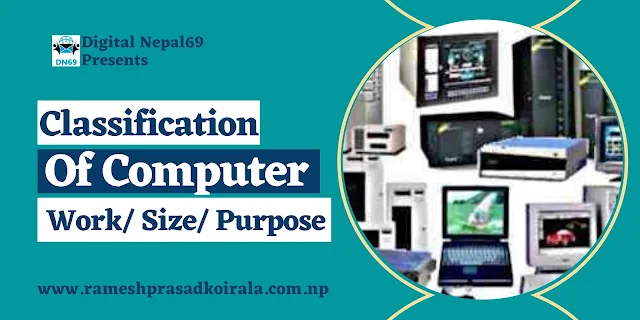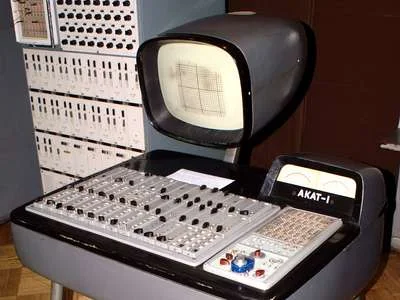On the basis of Work:
According to work, Computers are classified in three groups i.e. Analog Computer, Digital Computer and Hybrid Computer.
1) Analog Computer: The computer that work with natural phenomena and physical values like earthquake measurement, speed of the wind, weight light etc is known as Analog computers. It is especially used in scientific work, medical and industrial field. These are special purpose computers. It measures physical values such as temperature or pressure that fall along a continuous scale in temperature or pressure.
Features of Analog computer
- It works on real time and no storage capacity.
- It gives in the form of a graph, signals, table etc.
- It uses the continuously variable aspects of physical phenomena such as electrical, mechanical, or hydraulic quantities to model the problem being solved
- The results given by analog computers have very less accuracy.
- They consume more power.
- Examples includes analog clock, speedometer, thermometer etc.
- They work with discrete values, i.e they process discrete data.
- The speed of digital computers is more in comparison to analog computers.
- It has two steps: On and Off.
- The results are more accurate.
- Their architecture is not as complex as analog computers.
- It is expensive than digital and analog computer.
- It has limited storage.
- designed for a specific application
- less versatile.
- more efficient.
- Instruction permanently programmed into the memory.
- comparatively faster than general purpose computer.
are used for special purposes in weather forecasting, space research, agriculture, engineering, meteorology, satellite operation, traffic control, and research in chemical sciences.
- designed to perform variety or task.
- more versatile.
- less efficient.
- Programs are temporarily stored in memory.
- comparatively slower than special purpose computer.
- are very fastest, powerful, and expensive
- are specially made to perform multi-specific tasks
- CPUs work in parallel order
- are Multiprocessing or Parallel Processing.
- Used in
- research and study of energy,
- nuclear weapons and designing the aircraft, airplanes, and flight simulators,
- Climate research and Weather Forecasting and Prediction of Natural Disasters,
- Spaceship and Satellite Launching,
- scientific research laboratories etc.
- Chemical and Biological research
- highly calculation complex tasks.
- Examples: IBM Roadburner, IBM Blue Gene, Intel ASI Red. PARAM-1000, and CRAY-XMP-14.
- multi-programming, high-performance computers, and multi-user
- storage capacity is enormous, with a high-speed data process as well.
- can handle hundreds of input and output devices at a time.
- mainly used by departmental and commercial organizations like Banks, Companies, Scientific research centers, etc
- Used in
- keeping details of payments,
- research centres,
- advertising,
- sending bills and notices,
- paying employees,
- ticket booking,
- maintaining details of purchases by users,
- keeping detailed tax details, etc.
- Examples: IBM Es000 series, ICL39 Series, and CDC 6600.
- are the medium type of computers that have more functionality power and are expensive than microcomputers.
- the size, storage, and speed of minicomputers are large but less than the mainframe and supercomputers.
are made for performing multiple computing tasks at a single point of time, instead of assigning many microcomputers for a single task, which will be time-consuming and expensive

is a multi-threaded system (several processes at a time) capable of supporting from one to up to 200 users simultaneously: these computers are currently used to store large databases, multi-user applications, and the automation industry.
used as real-time applications in Industries, bookings, and Research Centres. Banks also use minicomputers for preparing payroll for employees’ salaries, records, tracking of financial accounts, etc. As well as in the field of Higher Education and Engineering.
Examples: PDP 11 and IBM (8000 Series).
4) Macro Computer:- is minimal in size and storage capacity
consist of many parts like Input and Output devices, Software, operating systems, networks, and Servers all these need to connect to form a complete Personal Digital Computer.
used in many fields like home, office, data collection, business, education, entertainment, publishing, etc.
keeps the details and prepares letters for correspondence in small businesses, creating bills, accounting, word processing, and operation of the filing systems in a large company.
Examples: Desktops, tablets, smartphones, and Laptops.
- Produce By International Business Machine(IBM) company.
- first company that manufactured computer
- Example: Original IBM PC, XT and AT.
- Founded by Herman Hollerith in 1923
- is based on IBM principle
- also known as IBM duplicate computer.
- Example: similar to the original IBM PC, XT, and AT.
- developed by Apple Industry
- used a standard microprocessor chips.
- used their own software.
- refers to Extra Technology.
- cannot support GUI based operating system
- processing speed is 4.77 MHz and word length 4 bits
- used Intel 8080, 8086, 8088 series of microprocessors
- refers to Advance Technology.
- supports GUI based operating systems
- processing speed is 2 GHz and word length 64 bits
- used Intel series of 80286, 80386, Pentium II etc.
- refers to Personal System/2
- operated with OS/2 operating system.
- used rechargeable and battery based system.










